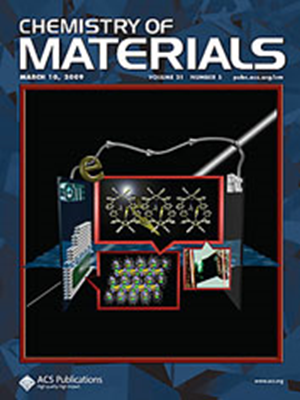提高高熵锑化物超导体 (RuRhPdIr)1-xPtxSb 的超导转变温度和上临界磁场
IF 7
2区 材料科学
Q2 CHEMISTRY, PHYSICAL
引用次数: 0
摘要
近年来,高熵化合物因其源自鸡尾酒效应的特殊性质和功能而备受关注。鸡尾酒效应表明,高熵化合物的性质将比从组成元素的单个性质中获得的平均性质显著增强。在此,我们报告了高熵锑化物超导体 (RuRhPdIr)1-xPtxSb(其中 x 表示铂含量)中作为新鸡尾酒效应的超导转变温度(Tc)和上临界磁场(Hc2)的提高。输运测量结果表明,在 x = 0.2 时,由于电子和声子的散射极强,会产生不同寻常的输运特性,而在 x = 1(PtSb)时,则会出现正常金属态的系统变化。Tc 也随着铂含量的变化而变化,这可能归因于电子-声子耦合的变化,在 x = 0.4 时达到最大值 3.1 K。这是过渡金属单锑化物中的最高值。x = 0.2 时的 Hc2 值是 x = 1 时的 7 倍,这可能是由于化学紊乱导致相干长度缩短所致。这项研究表明,高熵化合物中极强的化学紊乱可能会有效改善其超导特性。本文章由计算机程序翻译,如有差异,请以英文原文为准。

Increased Superconducting Transition Temperature and Upper Critical Field of a High-Entropy Antimonide Superconductor (RuRhPdIr)1–xPtxSb
High-entropy compounds have garnered significant interest in recent years owing to their exceptional properties and functionalities derived from the cocktail effect, which indicates that the properties of high-entropy compounds will be significantly enhanced compared to the average properties obtained from the individual properties of the constituent elements. Herein, we report an increased superconducting transition temperature (Tc) and upper critical field (Hc2) as a new cocktail effect in the high-entropy antimonide superconductor (RuRhPdIr)1–xPtxSb, where x denotes the Pt content. Transport measurements revealed a composition-dependent systematic change from unusual transport properties due to the extremely strong scattering of electrons and phonons for x = 0.2 to a normal metallic state for x = 1 (PtSb). Tc also varied with the Pt content, which could be attributed to the change in the electron–phonon coupling, reaching a maximum of 3.1 K at x = 0.4. This was the highest value among the transition metal mono antimonides. The Hc2 value for x = 0.2 was 7 times higher than that for x = 1, which is likely attributed to the shortening of the coherence length due to chemical disorder. This study demonstrates that extremely strong chemical disorders in high-entropy compounds may be effective in improving their superconducting properties.
求助全文
通过发布文献求助,成功后即可免费获取论文全文。
去求助
来源期刊

Chemistry of Materials
工程技术-材料科学:综合
CiteScore
14.10
自引率
5.80%
发文量
929
审稿时长
1.5 months
期刊介绍:
The journal Chemistry of Materials focuses on publishing original research at the intersection of materials science and chemistry. The studies published in the journal involve chemistry as a prominent component and explore topics such as the design, synthesis, characterization, processing, understanding, and application of functional or potentially functional materials. The journal covers various areas of interest, including inorganic and organic solid-state chemistry, nanomaterials, biomaterials, thin films and polymers, and composite/hybrid materials. The journal particularly seeks papers that highlight the creation or development of innovative materials with novel optical, electrical, magnetic, catalytic, or mechanical properties. It is essential that manuscripts on these topics have a primary focus on the chemistry of materials and represent a significant advancement compared to prior research. Before external reviews are sought, submitted manuscripts undergo a review process by a minimum of two editors to ensure their appropriateness for the journal and the presence of sufficient evidence of a significant advance that will be of broad interest to the materials chemistry community.
 求助内容:
求助内容: 应助结果提醒方式:
应助结果提醒方式:


